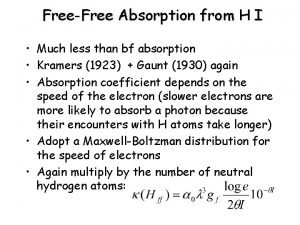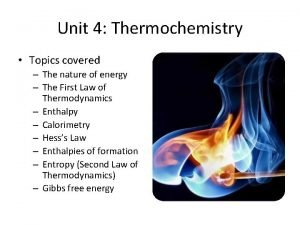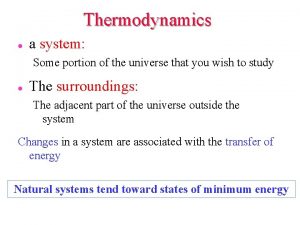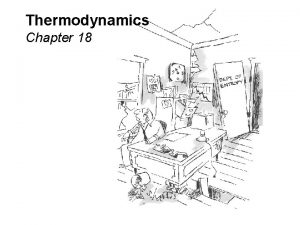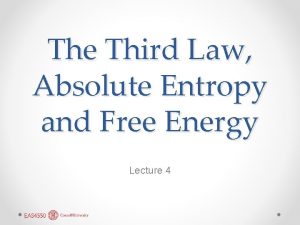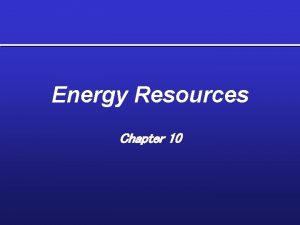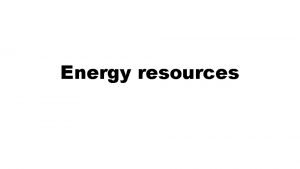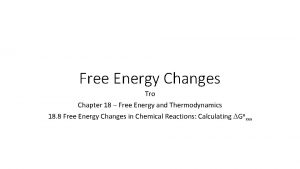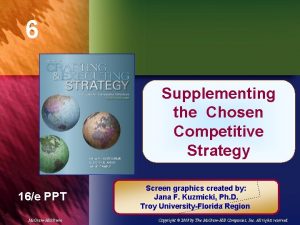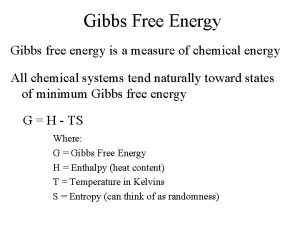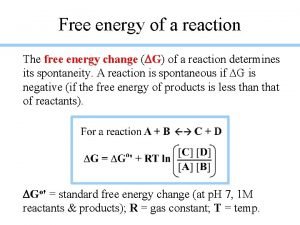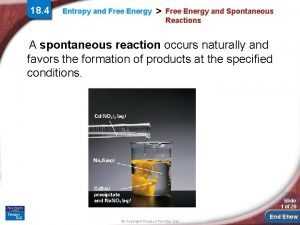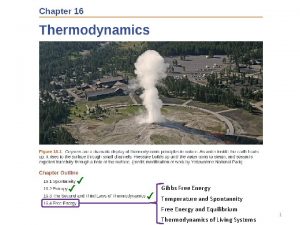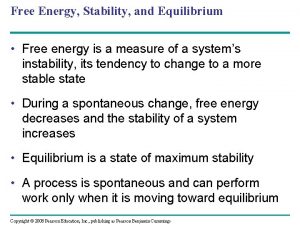Energy Resources Chapter 10 Energy Resources Supplementing free






















- Slides: 22

Energy Resources Chapter 10

Energy Resources • Supplementing free solar energy – 99% of heat comes from the sun – Without the sun, the earth would be – 240 0 C (-400 0 F) • We supplement the other 1% with primarily non-renewable energy sources

Energy Resources • Renewable (16%) – – Solar Wind Falling, flowing water Biomass • Non-renewable (84%) – – Oil Natural gas Coal Nuclear power

Energy sources and uses • Energy uses in developed countries – industrial – domestic – transportation • Note: Electricity is not an energy source, converted from another source (coal, hydro, nuclear, etc. ). • 1 st Law of Thermodynamics - You can’t get more energy out of something than you put in • 2 nd Law – In any conversion of heat energy to useful work, some energy is always degraded to a lower quality energy. I. E you lose energy

Evaluating Energy Resources • Renewable • Future availability • Net energy yield • It takes energy to get energy • • • Habitat degradation Cost (initial and ongoing) Community disruption Political or international issues Suitability in different locations Polluting (air, water, noise, visual)

Each type of power project needs to be evaluated for the benefits and costs

The environmental costs of hydroelectricity are much different than wind power, for example

Important Nonrenewable Energy Sources

North American Energy Resources US has only 2. 4% of world’s oil reserves Average American uses in one day what a person in the poorest countries use in one year

OIL and NATURAL GAS • • Accumulations of dead marine organisms on the ocean floor were covered by sediments. Muddy rock gradually formed rock (shale) containing dispersed oil. Sandstone formed on top of shale, thus oil pools began to form. Natural gas often forms on top of oil. • Primary component of natural gas is methane


Based on boiling points Oil • Petroleum (crude oil) • Costs: • • Recovery Refining Transporting Environmental • Highest risks are in transportation • Refining yields many products • • • Asphalt Heating oil Diesel Petrochemicals Gasoline …

Conventional Oil Advantages • Relatively low cost • High net energy yield • Efficient distribution system Disadvantages • Running out • 40 -90 years by some estimates • Low prices encourage waste • Air pollution and greenhouse gases • Water pollution

Arctic National Wildlife Refuge Controversy: Trade-offs • Would create jobs • Oil resources are uncertain • Uncertain environmental impacts

Oil & Gas Potential

Oil Shale and Tar Sands Tar Sand: Mixture of clay, sand water and bitumen a thick and sticky heavy oil. Oil Shale: Oily rocks that contain a solid mix of hydrocarbons. Extracted by large electric shovels, mixed with hot water and steam to extract the bitumen. Global supplies ~ 240 times conventional oil supplies. Bitumen heated to convert to synthetic crude oil.


Natural Gas • 50 -90% methane • Cleanest of fossil fuels • Approximate 200 year supply • Advantages and disadvantages

Coal – What is it? • Solid fossil fuel formed in several stages • Land plants that lived 300 -400 million years ago • Subjected to intense heat and pressure over many millions of years • Mostly carbon, small amounts of sulfur

Coal Formation and Types

Coal – what do we use it for? • Stages of coal formation • 300 million year old forests • peat > lignite > bituminous > anthracite • Primarily strip-mined • Used mostly for generating electricity • Used to generate 62% of the world’s electricity • Used to generate 52% of the U. S. electricity • Enough coal for about 200 -1000 years • U. S. has 25% of world’s reserves • High environmental impact • Coal gasification and liquefaction

Coal: Trade-offs World’s most abundant fossil fuel Mining and burning coal has a severe environmental impact Accounts for over 1/3 of the world’s CO 2 emissions
 Gibbs free energy vs standard free energy
Gibbs free energy vs standard free energy Gibbs free energy non standard conditions
Gibbs free energy non standard conditions G = - rt ln k
G = - rt ln k Helmholtz free energy
Helmholtz free energy Chapter 12 nonrenewable energy resources
Chapter 12 nonrenewable energy resources The allocation map
The allocation map Happy isles ulysses
Happy isles ulysses Summary of the story of an hour
Summary of the story of an hour Free free absorption
Free free absorption Slidescarnival.com/extra-free-resources-icons-and-maps
Slidescarnival.com/extra-free-resources-icons-and-maps Transformed and transforming resources
Transformed and transforming resources Variable resources examples
Variable resources examples Renewable resources vs nonrenewable resources
Renewable resources vs nonrenewable resources Energy energy transfer and general energy analysis
Energy energy transfer and general energy analysis Energy energy transfer and general energy analysis
Energy energy transfer and general energy analysis Chapter 7 energy conservation of energy
Chapter 7 energy conservation of energy Gibbs free energy unit
Gibbs free energy unit Gibbs free energy vs temperature
Gibbs free energy vs temperature Standard free energy change formula
Standard free energy change formula Absolute entropy
Absolute entropy Helmholtz free energy
Helmholtz free energy Gibbs free energy and spontaneity
Gibbs free energy and spontaneity Gibbs duhem equation
Gibbs duhem equation








